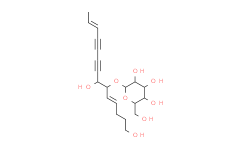
| Size | Price | Stock | Qty |
|---|---|---|---|
| 25mg |
|
||
| 50mg |
|
||
| 100mg |
|
||
| Other Sizes |
|
| Targets |
bioactive compound
|
|---|---|
| ln Vitro |
Lobetyolin, lobetyol, and methyl linoleate inhibited the gene expression of MUC5AC mucin induced by PMA; lobetyolin did not affect PMA-induced MUC5AC mucin production. However, lobetyol and methyl linoleate inhibited the production of MUC5AC mucin; lobetyolin and lobetyol did not significantly affect PMA-induced MUC5AC mucin secretion from NCI-H292 cells. However, methyl linoleate decreased the MUC5AC mucin secretion.[1]
|
| Cell Assay |
Confluent NCI-H292 cells were pretreated with lobetyolin, lobetyol, or methyl linoleate for 30 minutes and then stimulated with phorbol 12-myristate 13-acetate (PMA) for 24 hours. The MUC5AC mucin gene expression, and mucin protein production and secretion were measured by reverse transcription polymerase chain reaction and enzyme-linked immunosorbent assay, respectively.[1]
|
| References |
[1]. Yoon YP, et al. Effects of Lobetyolin, Lobetyol and Methyl linoleate on Secretion, Production and Gene Expression of MUC5AC Mucin from Airway Epithelial Cells. Tuberc Respir Dis (Seoul). 2014 Nov;77(5):203-8.
[2]. He W, et, al. Lobetyolin induces apoptosis of colon cancer cells by inhibiting glutamine metabolism. J Cell Mol Med. 2020 Mar;24(6):3359-3369. |
| Molecular Formula |
C20H28O8
|
|---|---|
| Molecular Weight |
396.4315
|
| Exact Mass |
396.1784
|
| CAS # |
136085-37-5
|
| Appearance |
White to yellow solid
|
| Source |
Codonopsis pilosula
|
| LogP |
-0.6
|
| tPSA |
140Ų
|
| SMILES |
O1[C@]([H])([C@@]([H])([C@]([H])([C@@]([H])([C@@]1([H])C([H])([H])O[H])O[H])O[H])O[H])OC([H])(/C(/[H])=C(\[H])/C([H])([H])C([H])([H])C([H])([H])O[H])C([H])(C#CC#C/C(/[H])=C(\[H])/C([H])([H])[H])O[H]
|
| InChi Key |
MMMUDYVKKPDZHS-UPPVCQNNSA-N
|
| InChi Code |
InChI=1S/C20H28O8/c1-2-3-4-5-7-10-14(23)15(11-8-6-9-12-21)27-20-19(26)18(25)17(24)16(13-22)28-20/h2-3,8,11,14-26H,6,9,12-13H2,1H3/b3-2+,11-8+/t14?,15?,16-,17-,18+,19-,20-/m1/s1
|
| Chemical Name |
(2R,3R,4S,5S,6R)-2-[(4E,12E)-1,7-dihydroxytetradeca-4,12-dien-8,10-diyn-6-yl]oxy-6-(hydroxymethyl)oxane-3,4,5-triol
|
| HS Tariff Code |
2934.99.9001
|
| Storage |
Powder -20°C 3 years 4°C 2 years In solvent -80°C 6 months -20°C 1 month |
| Shipping Condition |
Room temperature (This product is stable at ambient temperature for a few days during ordinary shipping and time spent in Customs)
|
| Solubility (In Vitro) |
DMSO: ~50 mg/mL (126.1 mM)
H2O: ~50 mg/mL (126.1 mM) |
|---|---|
| Solubility (In Vivo) |
≥ 2.5 mg/mL (6.3 mM) in 10% DMSO + 40% PEG300 + 5% Tween-80 + 45% Saline
≥ 2.5 mg/mL (6.3 mM) in 10% DMSO + 90% (20% SBE-β-CD in saline) ≥ 2.5 mg/mL (6.3 mM) in 10% DMSO + 90% Corn oil (Please use freshly prepared in vivo formulations for optimal results.) |
| Preparing Stock Solutions | 1 mg | 5 mg | 10 mg | |
| 1 mM | 2.5225 mL | 12.6126 mL | 25.2251 mL | |
| 5 mM | 0.5045 mL | 2.5225 mL | 5.0450 mL | |
| 10 mM | 0.2523 mL | 1.2613 mL | 2.5225 mL |
*Note: Please select an appropriate solvent for the preparation of stock solution based on your experiment needs. For most products, DMSO can be used for preparing stock solutions (e.g. 5 mM, 10 mM, or 20 mM concentration); some products with high aqueous solubility may be dissolved in water directly. Solubility information is available at the above Solubility Data section. Once the stock solution is prepared, aliquot it to routine usage volumes and store at -20°C or -80°C. Avoid repeated freeze and thaw cycles.
Calculation results
Working concentration: mg/mL;
Method for preparing DMSO stock solution: mg drug pre-dissolved in μL DMSO (stock solution concentration mg/mL). Please contact us first if the concentration exceeds the DMSO solubility of the batch of drug.
Method for preparing in vivo formulation::Take μL DMSO stock solution, next add μL PEG300, mix and clarify, next addμL Tween 80, mix and clarify, next add μL ddH2O,mix and clarify.
(1) Please be sure that the solution is clear before the addition of next solvent. Dissolution methods like vortex, ultrasound or warming and heat may be used to aid dissolving.
(2) Be sure to add the solvent(s) in order.